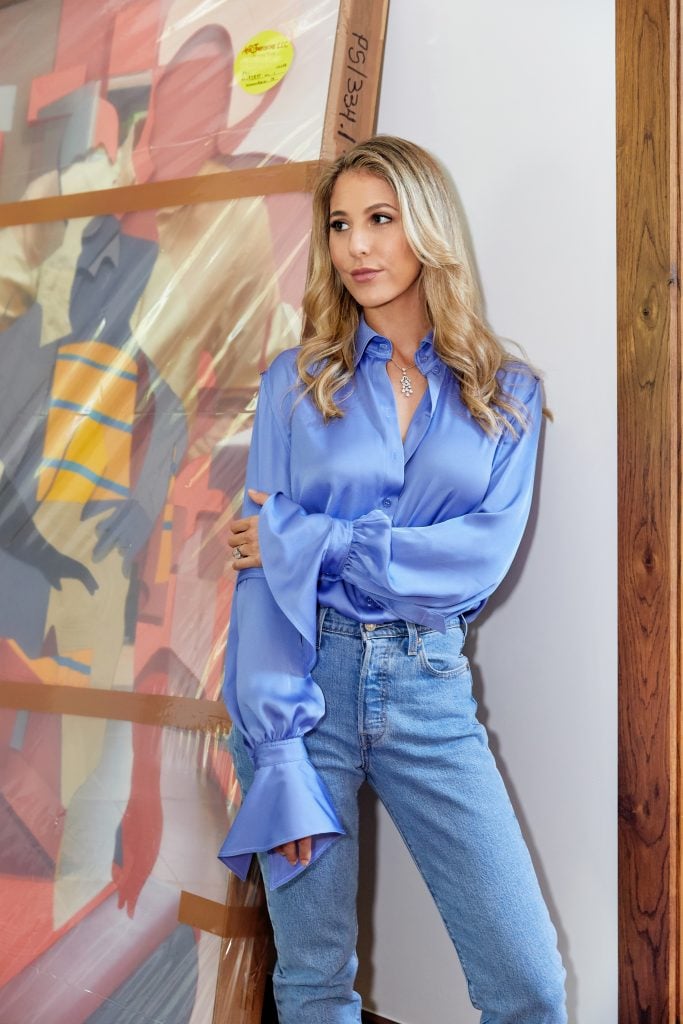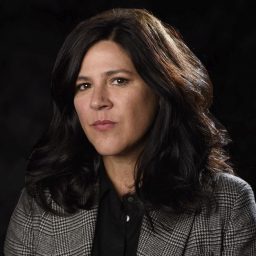Picture this: you’re just a few years old, and you’re playing a game of hide and seek with your siblings. As they count down from 100, you scan the room before you, deciding where to go. The options available to you for ducking away from view are endless—and many of them are behind or inside famous works of art.
The childhood of art advisor and collector Elizabeth Margulies—the daughter of the Miami-based mega collector Martin Margulies—was informed by memories like this one. Ever since she can remember, art has played a major role in her life, shaping her passions, interests, and professional pursuits. Art is, and has always been, she says, a lens through which she’s learned to understand more about the human condition and the experiences of others—a valuable means of cultivating empathy and connecting with the universal emotions we all feel.
In many ways, Margulies has parlayed all she’s learned about the art world from her family into her own career, beginning first with her early years working in the gallery sector (which were documented on Bravo’s show Gallery Girls in 2012, before she eventually decided to pursue her own path as an art advisor). Today, she advises both private and corporate clients alike, from real estate to the hospitality and entertainment industries. In the last few years, Margulies has also begun building her own collection, with works by artists such as Mickalene Thomas, Ivy Haldeman, Rashid Johnson, Alex Katz, and many more.
Not too long ago, Margulies sat down with Artnet News to discuss how her art-filled childhood paved the way for her own career as an art collector, advisor, and admirer of art.
How old were you when you first started engaging with art? Is there a particular work of art you remember seeing as a child that really wowed you?
Art was a critical part of everyday life in our family, so all my early memories are linked to one work or another. My mom would take me around to all the paintings and tell me about them when I was a baby. My brothers and I played hide and seek as kids and hid inside a lot of the sculptures. My dad let us play and touch things—nothing was ever damaged, even with four kids and their friends running around the house.
It’s hard to identify one specific work as my favorite, since there were so many. Two that come to mind instantly are a soft sculpture of a baked potato by Claes Oldenburg (one of my favorite hiding spots), and a George Segal New York subway sculpture (another great hiding spot). My first memory of the city was that subway sculpture, and I ended up living there for over a decade.
Your father, Martin Margulies, is of course one of the art world’s foremost collectors. What do you remember about the way in which he engaged with art while you were growing up?
While in Miami in the ‘80s, when I was born, we lived in a condominium at Grove Isle, one of my dad’s real estate developments in Coconut Grove. Our building was surrounded by the beautiful blue waters of Biscayne Bay, and my dad put his sculpture collection all over the island for people who lived there to enjoy daily. There were large sculptures by Richard Serra, Mark di Suvero, Jean Dubuffet, and Anthony Caro, among others, all over the property. This was my first memory of seeing any sort of large-scale public art outside of a museum.
What I love about my dad is that he never limited his collection to one type of work, or to one category of artist. We went to all sorts of artists’ studios, galleries, fairs, and exhibitions. It didn’t matter how big or small or how well known they were. He often bought works by emerging artists, and many unconventional things that most people thought were pretty strange at the time. I remember when he bought a warehouse in the Wynwood area of Miami because he could no longer fit all of his art and sculpture inside our home. Opening his collection to the public showed me that collecting should be more than acquiring expensive objects to hang on your walls.
What’s a piece of advice he gave you about collecting that’s stayed with you?
Buy works that you love, and live with them. The rest is secondary.
Tell me a little about your background in the art world. Did you go to art school? When did you realize you were interested in pursuing art professionally?
Growing up surrounded by so much art, I would often fantasize about one day becoming an artist. I attended the School of Visual Arts in New York City and majored in design. I soon realized how important having an in-depth knowledge of art history is as a foundation when working in the art world, so I decided to pursue my master’s degree at the Sotheby’s Institute in New York.
Which artists did you connect with most growing up and which do you connect with most now? Has your taste evolved over the years, and, if so, in what ways?
I connected with most of the art I grew up with because it was around me every day. Most of these works are iconic figures in art history. It’s very helpful to have this context and knowledge when looking at the work of contemporary artists today.
What do you think makes good art? What makes great art? What’s the difference?
Good art might be works you love, but generally lack support from industry experts. Great art is measured by a consensus of informed individuals like critics, collectors, institutions, gallerists, and other artists—all of whom are involved in the art world in a sincere manner because they are passionate about the arts.
We saw some of your early years in the gallery world chronicled on the Bravo show Gallery Girls, but you’ve since carved your own path in the industry as an art advisor. Tell me a little about how and why you started your business.
Art has been a constant source of joy in my life, and has been extremely educational for me. You learn a lot about history and the experiences of others through art. I know that art has the ability to change perspectives and spark conversations, which can sometimes carry a lot of emotion. I knew that I wanted others to experience this in their own way in their everyday lives, so I started my business to help make art accessible to people who may not have otherwise experienced it, and to help provide a platform for artists to be seen and heard. This is why I work on public-facing projects like hotels, real estate developments, public art projects, and so forth.
I also really enjoy working with young collectors and introducing them to artists and galleries. Many of my clients are quite surprised that a lot of the works I show them are within their budgets and are more affordable than they would’ve guessed. The art world can be very intimidating, especially when customer service at galleries is nonexistent. When you walk into a gallery off the street, you will not garner attention unless you’re a known collector. Typically, special treatment is reserved for “VIP” collectors who have done substantial business with the gallery, or are generally well-known collectors that the gallery has been trying to engage. Leveraging my experience and relationships is very important, as it provides a way for my clients to navigate an otherwise opaque industry.
Starting a professional career in the art world is very difficult, too, because it is all too often coupled with earning below a living wage, which in some ways creates an environment in which only the very privileged can pay their dues. I find this very problematic because it perpetuates an art world that is less inclusive from a socioeconomic perspective. There are too many brilliant college graduates who simply cannot afford to work in the art business in New York City and around the world.
When did you begin to collect art yourself? What were some of your early acquisitions like?
I started collecting a few years ago when I was first able to afford works by artists I had been following for some time. One of the first works I bought was a pink suit painting by Ivy Haldeman. Her work has a classic pinup feel to it. I also bought four photographs of Bettie Page, taken by an anonymous photographer. They hang next to the Ivy Haldeman painting.
How is your collecting style different or similar to your father’s?
My father and I grew up in very different times, so we have different views of the world. My view and the experiences I’ve had in my life have shaped my personality, and my personality shapes my collection. We both collect works that we connect to emotionally.
My dad’s parents were Polish immigrants who moved to New York before the war and opened a grocery store in Harlem, where they also lived. He spent a lot of time in Harlem at the store as a little boy, interacting with the people who shopped there and delivered the groceries. I think that’s why he gravitates to artworks that are about or that in some way captures the human condition and the everyday lives and experiences of hard-working people.
A lot of my dad’s stories and the shows we’ve seen together have naturally influenced my collecting. I tend to gravitate to artwork relating to women—that includes works by female artists, and works by male artists that depict females. I guess I hadn’t thought about it until now, but most of the work I like is related to women and the representation of females throughout art history and society.
What are some of the more recent pieces you’ve acquired? What attracted you to those works?
I’ve acquired works by Mickalene Thomas, Rashid Johnson, Alex Katz, Eddie Martinez, Gary Simmons, Jonathan Lasker, and Austin Lee.
These are all artists I’ve admired for quite some time. Sometimes it takes time to find the right work that you connect with and absolutely must have in your collection, especially when you have such a discerning eye. I have my father to thank for the critical way I evaluate the purchase of art. I want a paramount example of an artist’s work to be included in my collection.
Are there any emerging artists that you feel should be on people’s radar?
Kennedy Yanko, Federico de Francesco, Ivy Haldeman, and Tom Waring.
How do you like to display your art in your home?
On the walls. We buy works that we love, and then we figure out where we’ll hang them. Sometimes I like to hang certain related artworks near each other. For example, we’ll hang a Barry McGee work next to an OSGEMEOS painting because that feels right and meaningful.
What’s one tip you give to people who are looking to start collecting who don’t know anything about it?
Seeing museum shows is extremely important, especially retrospectives, because you can see a lot of one artist’s work and really learn about their oeuvre. Curators at these institutions are a very critical part of the art ecosystem, and the exhibitions they put together shape art history. The more art you see, the more you learn about what you like and what formulates your aesthetic.









